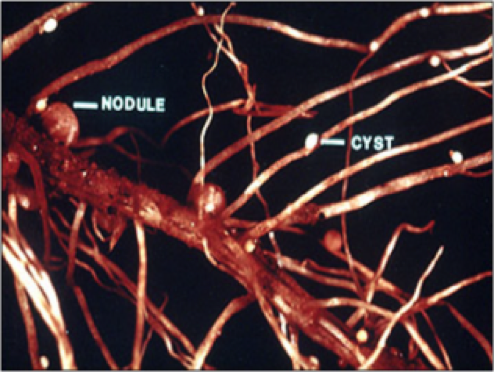Jaime A. Cummings1, Gary C. Bergstrom1, David M. Thurston1,2, and Xiaohong Wang1,2
1School of Integrative Plant Science, Plant Pathology and Plant-Microbe Biology Section, Cornell University; and 2USDA-ARS
In coordination with a statewide soybean disease survey, soil samples were collected from soybean fields from 17 counties throughout New York beginning in 2013 to search for the presence of the soybean cyst nematode (SCN) (Fig 1). Surveys were enabled with support of the Northern New York Agricultural Development Program, the New York State Corn and Soybean Growers Association Soybean Check-off Program, and USDA-NIFA Hatch and Smith Lever funds. After four years of intensely surveying field soils from western through northern NY counties, the nematode has now been identified and confirmed in Cayuga County. The survey was coordinated by Cornell University’s Field Crops Pathology program under the direction of Dr. Gary Bergstrom and Research Support Specialist Jaime Cummings in collaboration with numerous Cornell Cooperative Extension Educators and countless soybean growers throughout the state. Nematode extraction and initial identification was performed in Dr. Xiaohong Wang’s USDA ARS nematology lab at Cornell. Confirmation of the nematode’s identity as Heterodera glycines was made via microscopic examination by Dr. Zafar Handoo and via DNA sequence analysis by Dr. Andrea Skantar, both of the USDA-ARS in Beltsville, MD.
The soybean cyst nematode is considered the single largest cause of soybean yield losses nationwide and its occurrence has been confirmed in much of central and eastern North America (Fig. 2). Identifying and diagnosing SCN damage can be challenging, because aboveground symptoms, including stunting and chlorosis, may be vague and also caused by other abiotic stresses. Belowground symptoms include discoloration or necrosis of roots and reduced nodulation. The female nematodes may be visible on roots as very small white or yellow lemon-shaped cysts, and are easily distinguishable from nodules (Fig. 3). This pest was expected to be found at some point in New York soils, as it has been documented in areas of Canada adjacent to Niagara, St. Lawrence, Franklin, and Clinton Counties. However, low levels of the pest can be difficult to identify in soil samples, and may require multiple years of sampling before the pest population reaches a detectable level.


We should be vigilant in our continued search for the likely more widespread distribution of this potentially devastating pest throughout NY. Systematic research survey efforts through CCE collaborators will continue in 2017. Soil sampling for SCN analysis is recommended for growers who suspect infestation, and this service is available through the Plant Disease Diagnostic Clinic at Cornell University and other state and commercial laboratories (Fig. 4). Because the nematodes are very persistent in the soil, and have a complicated race structure, an integrated management approach is recommended. Management practices include crop rotation, planting race-specific, resistant varieties, nematicidal seed treatments, and cultural practices that reduce plant stress and optimize plant health and yield.

The results of this ongoing survey are now available in the soybean disease section of Cornell’s fieldcrops.org extension website https://fieldcrops.cals.cornell.edu/soybeans/diseases-soybeans/soybean-disease-survey. The website, updated annually, outlines the progress of the survey and the counties included in the survey. New York soybean growers can use this new tool to find information on which diseases/pests have been identified in their respective counties, along with information on each disease including epidemiology, diagnostic characteristics for in-field identification, and management options and recommendations.


